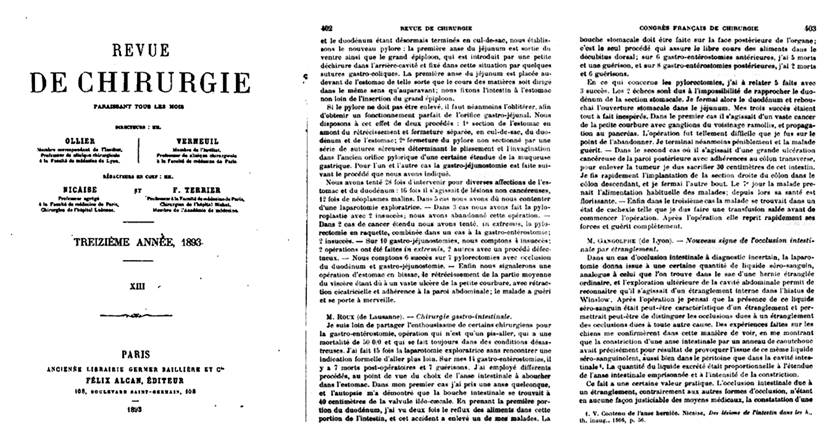The discovery, implementation, and development of asepsis, antisepsis, and anesthesia techniques allowed, coupled with the development of formal and better-structured programs and training in medicine and surgery, accessing body cavities considered inscrutable temples in the human being, such as the abdomen and the skull. Since then, and historically, there have been notable characters in the world of surgery, not only for their intellectual abilities that gave them a superior understanding of the human body in their time but also for their manual skills that led them to transcend in the history of surgery. One of these characters is César Roux, inventor and precursor of the surgery that bears his name: L’anse en Y selon Roux or Roux-en-Y anastomosis (Figure 1).

Figure 1 César Roux at the age of 42 (1899). Courtesy of Dr. Gustavo Martínez-Mier. Martínez-Mier G, Reyes-Devesa HE. César Roux. El cirujano y su anastomosis. Cir General. 2005;27(2):171-75.
César Roux was born on March 23, 1857, in Mont-la-Ville, Switzerland. He was the fifth of eleven children, and his father was a school inspector. He studied medicine at the University of Bern between 1874 and 1880, a university whose faculty included Theodor Langhans in pathology and Theodor Kocher in surgery. It was under the mentorship of Theodor Kocher that Roux undertook further training in surgery for three years at the University Hospital of Bern. He was early noted for his surgical skills that would bring him recognition in the scientific community of the time and would later lead him, at the age of 30, to be the chief of surgery at the Canton Hospital in Lausanne, Switzerland. Although his interest in surgery encompassed many areas, Roux had a particular interest in gastrointestinal surgery, and his contributions in this area were the most representative.
The first performance of a Roux-en-Y gastrointestinal reconstruction in a human was performed in 1892 as a treatment for anthropyloric obstruction, a general pathology that concerned and occupied the minds of great surgeons of the time, such as Theodor Billroth. This procedure was performed by adapting Anton Wölflers’ technique presented at the 12th Congress of the German Society of Surgery from an experiment in canines in which a Y-shaped anastomosis was performed with an end-to-side jejunojejunoanastomosis and a gastrojejunoanastomosis. In 1893, César Roux published his experience with 29 patients and detailed the steps to follow for his procedure (Figure 2), which included the section of a loop of jejunum at 15 to 30 cm from the ligament of Treitz, creating an afferent loop 10 to 12 cm long. The efferent loop (Y-loop) was anastomosed with the posterior wall of the stomach in a retrocolic position, and the anastomosis between the afferent and efferent loops was performed in an end-to-side position in three layers (Figure 3).

Figure 2 Original publication in the Revue de Chirurgie journal of the article in which César Roux describes his technique.

Figure 3 A. Subtotal gastrectomy and Roux-en-Y reconstruction. B. Total gastrectomy and Roux-en-Y reconstruction.
By 1897, Roux published his experience with the intervention in 50 patients and additional details about the procedure. Although the initial mortality was 21%, with a refinement of the technique, it was reduced to 11%, reasonably low mortality if one considers that Roux did not select low-risk patients and performed the procedure on all those in which it was technically possible even when they presented with tumor involvement. One of the main complications of this procedure was the appearance of ulcers at the edges of the gastrojejunoanastomosis, resulting in bleeding, pain, and perforations and causing the original technique to be modified by a side-to-end gastrojejunostomy that gave rise to the reflux of biliary and pancreatic secretions that neutralized gastric secretions. So, Roux abandoned his original procedure in 1911. Additionally, with the appearance of drugs that help control gastric secretion and vagotomies, the Roux-en-Y anastomosis fell into oblivion. Half a century later, this procedure was adopted again in multiple gastrointestinal surgical procedures with some modifications but keeping the basic principles described initially by César Roux1,2.
César Roux was also the first person to surgically remove a pheochromocytoma by adrenalectomy, seven months ahead of Charles Mayo3. Thanks to his tireless work and dedication to teaching and the welfare of his patients, César Roux enjoyed great prestige in Europe and was a prominent member of some of the most critical medical societies of the time, such as the Paris Surgical Society and the St. Petersburg Military Medical Academy; besides, he received several recognitions and awards throughout his career as a surgeon4.
Personally, different nuances of his character are described: a good sense of humor, but sometimes a strong temperament, an excellent vocation for work, and an outstanding commitment to his patients’ care. Harvey Cushing, who visited Lausanne in October 1900, describes him as “…a diamond in the rough who has worked his way into one of the best clinics in Switzerland. It is wonderful to see.”
In 1934, after returning to private practice, Roux died suddenly in his office; Switzerland declared national mourning. Roux left a surgical legacy that has endured for more than a century3.











 text in
text in 



